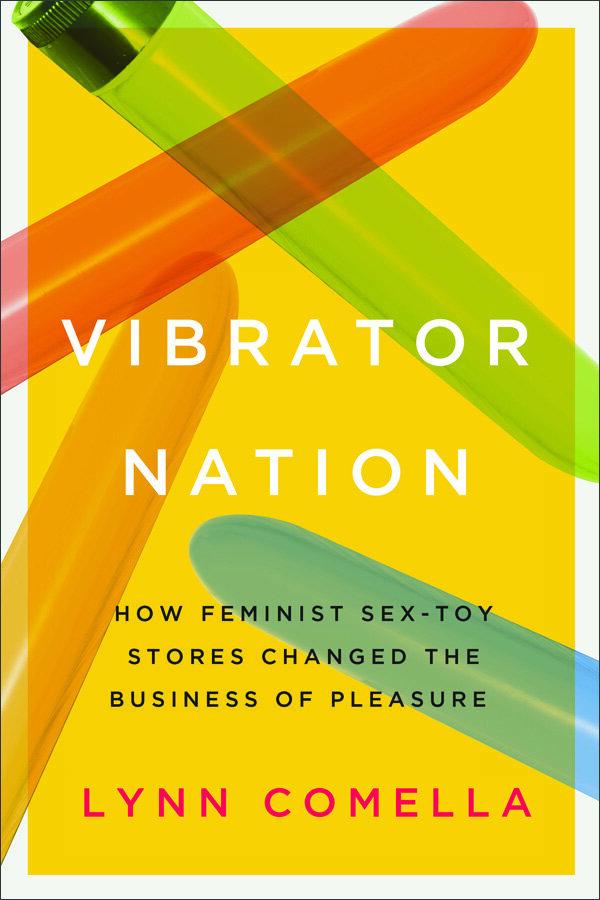More Than Just Sex Toys: On Lynn Comella’s “Vibrator Nation: How Feminist Sex-toy Stores Changed the Business of Pleasure”
Lynn Comella began research on the history of feminist sex-toy stores while she was a graduate student in the early 2000s. She conducted interviews with almost all the major players in the feminist sex-toy industry and even worked at sex-toy store called Babeland, where she sold products and educated consumers as part of her research. With all this collected information, she wrote Vibrator Nation: How Feminist Sex-Toy Stores Changed the Business of Pleasure, a tale of a small and tight-knit industry trying to balance the sometimes competing interests of financial solvency and sex-positive activism.
From its title and topic alone, Vibrator Nation might seem like a niche book written for an audience who wants to read about sex. But as an incisive exploration of gender, race, class, activism, capitalism, second- and third-wave feminism, and queer identity, it’s so much more. By framing all of this through the stories of how the market for brick-and-mortar feminist sex-toy stores was built and has evolved in the U.S., Comella presents a unique view on American history and sociology between the 1970s and 2000s. By the end of the introduction, readers will already note the book is much more about business, politics, and philosophy than it is about sex toys themselves.
In Comella’s exploration of how these spheres relate to one another, she acknowledges a variety of perspectives—including the idea that radical politics must be hostile to consumer capitalism, or that the sex industry itself is hostile to feminism—but eventually settles on a different thesis. “My research challenges these perspectives,” she writes in the introduction. “I argue that feminist sex-toy stores have created a viable counterpublic sphere for sex-positive entrepreneurship and retail activism, one where the idea that the personal is political is deployed in the service of a progressive – and potentially transformative – sexual politics.”
These fundamental tensions remain at the heart of Vibrator Nation, as the author picks apart assumptions and easy inferences about recent American history one sex-toy store narrative at a time. In particular, Comella focuses on how nearly all the owners of the earliest feminist sex-toy stores in the 1970s deliberately and loudly stated that they weren’t, or barely were, interested in turning a profit. They instead viewed themselves as feminists, educators, radicals, and community resource providers. However, Comella doesn’t shy away from the fact that these women could afford not to care about profits because they were independently wealthy and were able to finance their business with their personal savings or loans from family members.
She also explores the implications of these stores’ deliberately chosen aesthetics; a ‘boutique’ feel with pastel colors, open spaces, and lots of natural light. According to Comella, these stores’ products weren’t attractive to all women but rather appealed to a particular type of woman—white, middle-class, straight—whose preferences and purchasing power had a great influence over which businesses were seen as respectable and which weren’t. Comella delves into what it means for a store to be seen as “good” and “safe” and “feminist” as opposed to “crass,” “sleazy,” and “dangerous,” and how these value judgments often relate to race, class, and sexuality as much as they have to do with a store owner’s individual progressive politics. When the people opening sex-toy stores had money and social capital, for example, they could afford to move into more commercially viable neighborhoods because they could pay for the retail space. Landlords would be more likely to accept the presence of wealthy white businesspeople. And building a business around aesthetics designed to appeal to straight, middle-class, white women brought an air of respectability because of the customer base it promised to draw in.
Comella credits Good Vibrations, a sex-toy store that opened its doors in the 1970s, with inspiring a generation of feminist and woman-centered sex-toy stores, and she uses the “Good Vibrations model” to explore the evolution of sex-toy businesses. She describes the evolution of these businesses like a family tree, tracing the business model’s genealogy from Good Vibrations and its predecessor All About Eve of the 1970s, to Grand Opening! and Babeland, whose founders interned at Good Vibrations before opening their stores in 1993, and to newer stores of the 2000s and 2010s, such as Feelmore and Smitten Kitten.
In discussing various stores’ business practices, Comella gives a series of striking examples about how the hard realities of economics shape a store’s ability to enact their politics within a capitalist framework, and she explores how possible it really is to be both a feminist and a business owner. Some businesses kept profit margins in mind while others didn’t, at least at first. Business founders learned marketing skills and customer service practices from those who came before them. And some attempted to put their radical politics into action by becoming worker co-ops. Comella’s analysis of this thorny topic is nuanced; she gives these business’ genuine social accomplishments and flaws an honest reckoning rather than brushing either part of the story aside.
Comella also delves into the demographics of sex-toy store employees as compared to the people who frequent the stores. She includes many interviews with queer and LGBT+ industry workers who have brought uniquely valuable contributions to sex positivity and sexual liberation for people of all genders. The popularity of diverse LGBT+ pornography and the ways it challenges assumptions about sex and relationships, for example, illuminates how customers were learning from queer lives and culture in the context of these sex-toy stores. Unfortunately, some of Comella’s writing on this topic uses dated language, such as “queer-identified” and “trans-identified” as opposed to simply “queer” and “trans.” For a scholarly book published in 2017 by an associate professor of gender and sexuality studies, there is no excuse for these unnecessary qualifiers.
Still, her interviews with sex-toy store owners and employees about gender, sexuality, and feminism are probing and unflinching. She investigates how these frameworks relate to who each store is for and whose needs it centers, including who is allowed to work and shop there. With these interviews, she offers a multifaceted look at what the meeting of second- and third-wave feminism looks like on the shop floor.
Comella devotes a particularly valuable chapter to delving into how her interview sources who currently work in the sex toy industry understand their own relationships with feminism. Some people say they think of feminism as ‘strange’ or ‘suspect’ or worry that others will think of it as a ‘dirty word,’ while some store employees aren’t quite sure what the word means anymore. However, it’s also clear that some version of feminism has been a constant thread through every version of these stores.
To show how a feminist mindeset can intersect with other social movements, Comella details the activities of Smitten Kitten, a store that advocated for safe production materials in sex toys. In 2003, the owners received their first shipment of sex toys, and when they opened the packaging, they discovered the toys had melted in the truck and were leaching an unidentified liquid. It turned out the sex toys were made with phthalates, chemicals that make plastics softer and are dangerous to the body. Since the FDA doesn’t regulate the chemicals in sex toys, Smitten Kitten, Self-Serve, and other socially-conscious stores led the charge for durable, high-quality, environmentally-friendly, and body-safe toys as part of a mission to empower people to learn about their bodies and explore what sex positivity can mean to them.
Ultimately, Vibrator Nation doesn’t answer nearly all the questions it raises about how feminism, the sex industry, and modern American history are evolving in parallel, and where and whether these parallels will diverge. But the book is as clear a demonstration as any of the value of finding new angles on sociological and historical research. By delving into the history of a young corner of a historically male-dominated industry and bringing female and queer perspectives to the fore, Comella tells a compelling story about the motivations and challenges facing eager activists of all generations in the U.S. today. If feminist sex-toy stores continue to serve as a barometer for larger social concerns, as they have until this point, I will be fascinated to read a follow-up book on this topic in 20, 30, or 40 years.
Image credit: Modern sex Toys by Fun Factor, 15 January 2012 (Wikimedia Commons | CC BY-SA 3.0)






